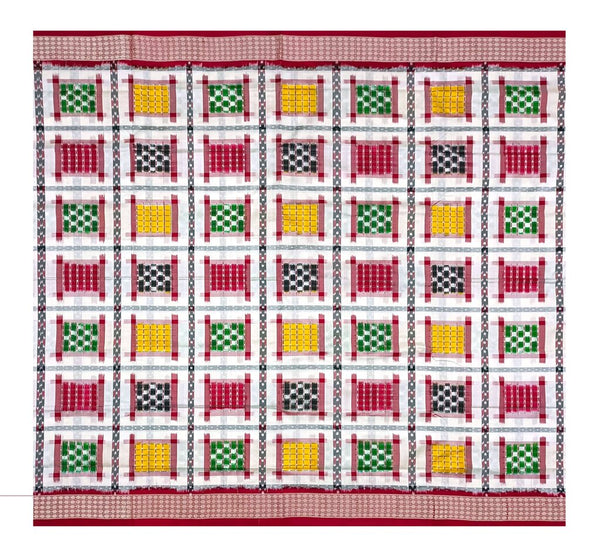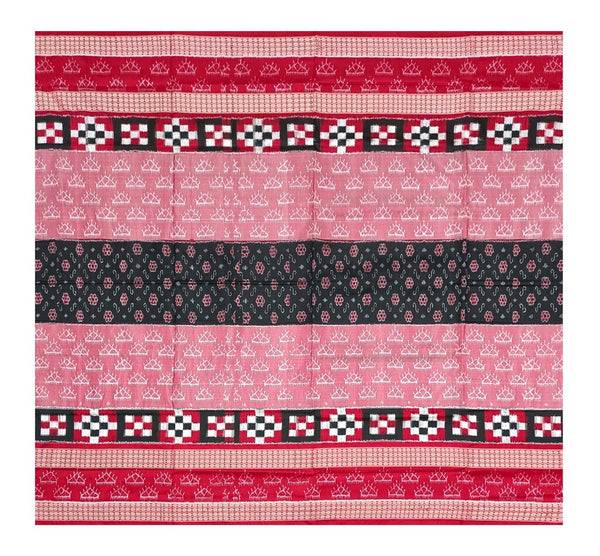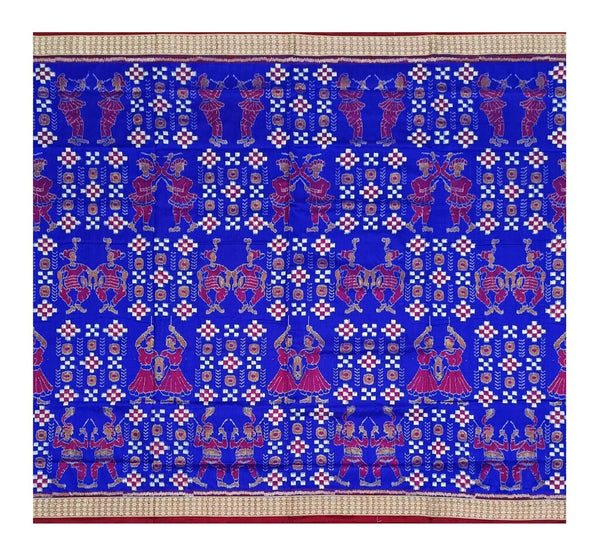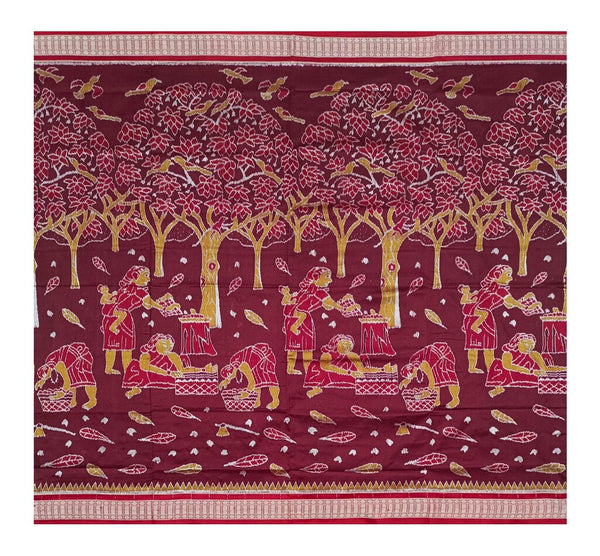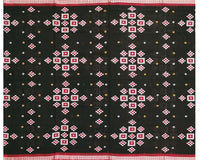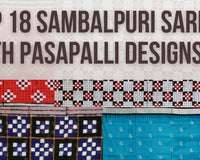Sarees are one of the most versatile and graceful garments in the world. They can be worn for any occasion, from casual to formal, and can suit any body type, skin tone, and personality. Among the many varieties of sarees, one of the most exquisite and unique is the Silk Sambalpuri Saree.
Sambalpuri Silk Sarees are handwoven sarees from the state of Odisha, India. They are known for their intricate and colourful designs, which are created using a special technique called ikat. Ikat is a form of tie-dyeing, where the yarns are dyed before weaving, creating patterns that are visible on both sides of the fabric. The process of making a Sambalpuri Silk Saree can take several months, as each saree is a masterpiece of craftsmanship and artistry.
In this blog post, we will explore the history, culture, and significance of silk Sambalpuri sarees, as well as give you some tips on how to buy, wear, and care for them. Whether you are a saree lover, a fashion enthusiast, or a curious traveller, this guide will help you appreciate the timeless elegance of Silk Sambalpuri saree.
History of Silk Sambalpuri Saree
The origin of Silk Sambalpuri sarees can be traced back to the 11th century, when the king of Sambalpur, Balaram Dev, invited weavers from other regions to settle in his kingdom and produce fine textiles. The weavers brought with them their skills and traditions and gradually developed a distinctive style of weaving that incorporated local motifs and colours. The silk sambalpuri sarees became popular among the royal and aristocratic families, as well as the common people, who wore them for festivals and ceremonies.
The silk sambalpuri sarees reached their peak of glory in the 19th century when they were exported to many countries, such as Burma, Indonesia, and Japan. They also attracted the attention of Mahatma Gandhi, the father of the nation, who praised them for their beauty and quality. He encouraged the weavers to continue their work and preserve their heritage, as part of his Swadeshi movement, which promoted the use of indigenous products.
However, the silk sambalpuri sarees faced a decline in the 20th century, due to the influx of cheaper and machine-made fabrics, as well as the loss of patronage and market. The weavers struggled to survive and maintain their craft, and many of them migrated to other occupations. The silk sambalpuri sarees were in danger of disappearing, until the government and various organizations intervened to revive and promote them.
Today, the silk sambalpuri sarees are recognized as a Geographical Indication (GI) product, which means that they are protected by law and can only be produced in certain regions of Odisha. They are also appreciated by celebrities, designers, and customers across the world, who admire their uniqueness and elegance.
Culture and Significance of Silk Sambalpuri Sarees
The silk Sambalpuri sarees are not just a piece of cloth, but a reflection of the culture and identity of the people of Odisha. They are inspired by the rich and diverse heritage of the state, which includes its natural beauty, religious beliefs, folk art, and social customs.
The motifs and colours of the Silk Sambalpuri sarees are symbolic of various aspects of the Odia culture, such as:
- Nature: The silk sambalpuri sarees often depict the flora and fauna of Odisha, such as flowers, leaves, fruits, birds, animals, and insects. Some of the common motifs are the lotus, the jasmine, the mango, the peacock, the elephant, and the butterfly. These motifs represent the harmony and abundance of nature, as well as the fertility and prosperity of the land.
- Religion: The silk sambalpuri sarees also reflect the religious diversity and tolerance of Odisha, which is home to many faiths, such as Hinduism, Buddhism, Jainism, and Islam. The sarees feature motifs that are associated with various gods and goddesses, such as Shiva, Vishnu, Lakshmi, Durga, and Ganesh. They also incorporate elements from the famous temples and monuments of Odisha, such as the Jagannath temple, the Konark sun temple, and the Lingaraj temple. These motifs express the devotion and reverence of the people, as well as the architectural and artistic excellence of the state.
- Art: The silk sambalpuri sarees are also influenced by the folk art and craft of Odisha, such as the pattachitra paintings, the applique work, the terracotta pottery, and the dhokra metal casting. The sarees display motifs that are derived from these art forms, such as the fish, the wheel, the tree of life, and the tribal figures. These motifs showcase the creativity and skill of the artisans, as well as the cultural and historical legacy of the state.
- Society: The silk sambalpuri sarees also represent the social and personal aspects of the Odia people, such as their festivals, rituals, occupations, and emotions. The sarees use colours that are associated with different occasions and moods, such as red for weddings, yellow for spring, green for prosperity, and white for peace. They also depict motifs that are related to the daily life and activities of the people, such as the boat, the plough, the wheel, and the musical instruments. These motifs convey the joy and simplicity of the people, as well as their pride and dignity.
How to Buy, Wear, and Care for Silk Sambalpuri Sarees
If you are interested in buying, wearing, or caring for a Silk Sambalpuri Saree, here are some tips and suggestions that will help you:
Buying
The best way to buy a silk Sambalpuri saree is to visit the local markets and shops in Odisha, where you can find a wide range of designs, colors, and prices.
You can also buy them online, from reputed and authentic websites, such as OdiKala, Sambalpuri Bastralaya, Sambalpuri Handloom, and Sambalpuri Saree. However, you should be careful of fake and imitation products, which are often sold as Silk Sambalpuri Sarees but are actually made of synthetic or mixed fabrics.
To identify a genuine silk Sambalpuri saree, you should look for the following features:
- The saree should have a GI tag, which certifies that it is produced in the designated regions of Odisha and meets the quality standards.
- The saree should have a handloom mark, which indicates that it is handwoven by a registered weaver, and not machine-made.
- The saree should have a silk mark, which verifies that it is made of pure silk, and not blended with other fibers.
- The saree should have a distinctive texture and feel, which is soft, smooth, and slightly coarse, due to the ikat technique. You can also rub the saree between your fingers, and listen for a crisp sound, which is a sign of pure silk.
- The saree should have a consistent and symmetrical pattern, which is visible on both sides of the fabric and does not fade or bleed. You can also check the reverse side of the saree, and look for the knots and threads, which are characteristic of the ikat technique.
Wearing
The silk Sambalpuri saree can be worn in different ways, depending on your preference, occasion, and style. You can drape it in the traditional Odia style, which is similar to the Bengali style, where the Pallu is brought from the back to the front and pleated over the right shoulder.
You can also drape it in the Nivi style, which is the most common and popular style, where the Pallu is pleated over the left shoulder, and left loose or pinned. You can also experiment with other styles, such as the Gujarati, the Maharashtrian, or the Indo-Western, which are more modern and trendier.
You can also accessorize your silk Sambalpuri saree with jewellery, footwear, and bags, that complement its colour and design. For example, you can wear silver or gold jewellery, depending on the tone of the saree, and choose earrings, necklaces, bangles, and rings, that match its motifs.
You can also wear heels, flats, or sandals, depending on your comfort and occasion, and choose a clutch, a pot, or a sling bag, depending on your need and style.
-
Caring: The silk Sambalpuri saree is a delicate and precious garment, which requires proper care and maintenance, to preserve its beauty and longevity. Here are some dos and don’ts that you should follow while caring for your silk Sambalpuri saree:
-
- Do wash your silk Sambalpuri Saree separately, by hand, in cold water, using a mild detergent or shampoo. Avoid using harsh chemicals, bleach, or machine wash, as they can damage the fabric and the colours.
- Do dry your Silk Sambalpuri Saree in a shaded area, away from direct sunlight, heat, or moisture. Avoid wringing, twisting, or ironing the saree, as they can cause wrinkles and creases. Instead, gently squeeze out the excess water, and hang the saree on a padded hanger, or spread it on a flat surface.
- Do store your Silk Sambalpuri Saree in a cool, dry, and dark place, preferably wrapped in a cotton or muslin cloth, or in a saree cover. Avoid folding the saree too tightly, or stacking it with other sarees, as they can cause permanent marks and tears. You can also use naphthalene balls, neem leaves, or cloves, to prevent insects and fungus from attacking the saree.
- Don’t expose your Silk Sambalpuri Saree to perfume, deodorant, or sweat, as they can stain and weaken the fabric. If you spill something on the saree, blot it immediately with a clean cloth, and wash it as soon as possible. If the stain is stubborn, you can use a mild soap or vinegar, or take it to a professional dry cleaner.
- Don’t wear your Silk Sambalpuri Saree too frequently, or for long hours, as they can cause wear and tear, and reduce the life of the saree. You should also change the folds and drapes of the saree occasionally, to avoid stress on the same areas. You can also pair your saree once in a while, to remove any dust or odour.
Conclusion
Silk Sambalpuri Sarees are one of the most beautiful and distinctive types of sarees in India. They are a symbol of the rich and diverse culture and heritage of Odisha and a testament to the skill and creativity of the weavers. They are also a versatile and elegant garment, that can suit any occasion, style, and personality.
By following this guide, you can learn more about the history, culture, and significance of Silk Sambalpuri Sarees, as well as how to buy, wear, and care for them. You can also explore the various designs, colors, and patterns of Silk Sambalpuri Saree, and find the one that matches your taste and preference.
Whether you are a saree connoisseur, a fashion lover, or a curious traveler, you will surely find a Silk Sambalpuri Saree that will make you feel special and beautiful.
FAQ
Here are some frequently asked questions and answers about Silk Sambalpuri Sarees:
Q: How much does a silk Sambalpuri saree cost?
A: The price of a silk Sambalpuri saree depends on various factors, such as the quality of the silk, the complexity of the design, the size of the saree, and the reputation of the seller. Generally, Sambalpuri Silk Sarees can range from Rs. 3000 to Rs. 30000, or more.
Q: How long does it take to make a Silk Sambalpuri Saree?
A: The time it takes to make a silk sambalpuri saree varies depending on the intricacy of the pattern, the number of colours used, and the skill of the weaver. Typically, it can take anywhere from 15 days to 6 months, or more.
Q: What are the different types of silk Sambalpuri sarees?
A: There are several types of silk Sambalpuri sarees, based on the region, the technique, and the motif. Some of the popular types are:
- Bomkai: Bomkai sarees are produced in the Bomkai village of Ganjam district and are known for their contrasting colours and geometric patterns. They also have a distinctive border and pallu, which are woven using the extra weft technique, creating a raised effect.
- Sonepuri: Sonepuri sarees are produced in the Sonepur district and are known for their fine, delicate designs, which are inspired by nature and mythology. They also have a smooth, glossy texture and a vibrant colour palette.
- Barpali: Barpali sarees are produced in the Barpali town of Bargarh district, and are known for their simple and elegant designs, which are mostly based on stripes, checks, and dots. They also have a soft and light feel and a subtle and sober colour scheme.
- Pasapali: Pasapali sarees are produced in the Bargarh district, and are known for their chessboard-like patterns, which are created using the double ikat technique. They also have a coarse and sturdy texture, and a contrasting and bold colour combination.


